‘Book Mystique Review - Get In The Picture With Quik Pod Pro Handheld Extendable Photographic Tripod
Wednesday, June 18, 2008
by Charles W. Moore
If you’re a longtime photography buff like, you probably have lots of photos of your immediate family, friends and acquaintances, and if applicable your spouse and kids but a noticeable scarcity of images with you in them. As the family designated photographer, I certainly ended up up being behind the camera a lot more often than not when my kids were growing up.
It would be different if I’d had a Quik Pod during those years. What’s a Quik Pod? It’s a telescopic handle with a photographic tripod screw and swivel socket at its outer end, to which you can attach a camera and get in the picture yourself.

It’s such a simple concept, it’s hard to fathom why it hasn’t been done before. If it has, it’s never came to my attention in all the years I’ve been around photography, and the manufacturer claims it’s “the world’s first handheld extendable tripod,” so I’ll provisionally take their word for it. The company says that The Quik Pod idea came to its inventor Wayne Fromm when he was traveling with his family and growing tired of asking strangers to operate his camera for family photos. Fromm has invented and marketed nearly fifty successful commercial products and is known particularly for his toy creations including Disney’s Beauty and the Beast Talking Mirror. Over one hundred prototypes were created before he successfully manufactured the Quik Pod.
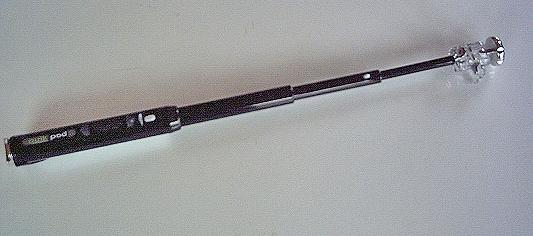
Another consideration is that for the Quik Pod concept to become really practical, development of digital photography was a prerequisite. Aiming and composing at arm’s length is a bit of a hit or miss proposition, especially at first, and the necessity of waiting for film processing in order to determine results, as well as the expense of botched shots, would have made the Quik Pod impractical in the days of analog film photography.
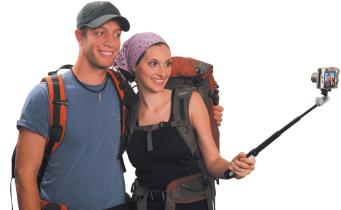
However, if you blow a shot with a digital camera, you get immediate confirmation, and you can just delete it and try again. Actually, one gets the hang of the Quik Pod pretty quickly, and if you buy one of these things, you’ll find it addictive - or at least I have.
Of course there was always the option of using a conventional tripod and the camera’s self-timer or a bulb release. I’ve used those methods many times, but it lacks spontaneity and poses tend to look stiff and formal with everyone gazing at the camera waiting for the self-timer to trip. A conventional tripod is also big and cumbersome to lug around.
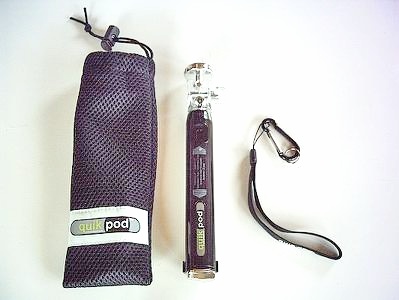

The Quik Pod is much more ad hoc, and the device itself is reasonably compact. It comes with a handy 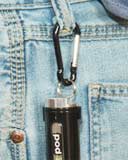 drawstring carry bag, as well as a carabiner you can use to clip it to a belt loop or backpack strap. A wrist strap is also supplied for more convenient and secure handling. The entire ensemble - Quick Pod, carry bag, carabiner, and strap weigh in at a modest 120 grams or 3.5 ounces. When retracted, the Quik Pod is just 7.5 inches long, so it’s really no hardship to take along.
drawstring carry bag, as well as a carabiner you can use to clip it to a belt loop or backpack strap. A wrist strap is also supplied for more convenient and secure handling. The entire ensemble - Quick Pod, carry bag, carabiner, and strap weigh in at a modest 120 grams or 3.5 ounces. When retracted, the Quik Pod is just 7.5 inches long, so it’s really no hardship to take along.
Using the Quik Pod is simple and intuitive. First extend the unit by pulling outward at its opposite ends. The Quik Pod is held open securely at its full 18.5” extension by detent buttons. Attach your camera to the Quik Pod’s tripod mount, angle and tilt can be set using the mount’s ball socket and thumbscrew adjustment.
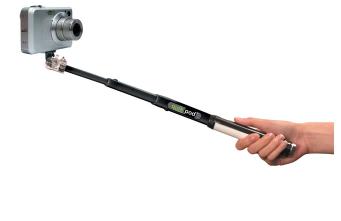
With the camera satisfactorily oriented, set the self-timer, activate the shutter, hold the Quik Pod mounted camera away from you, keep your arm low and angle the Quik Pod so that the camera lens is at roughly eye level or a bit above, and wait for the shutter to fire. There is a small, convex mirror on the camera amount to help with aiming, although you need sharp eyes. I found that it took a bit of trial and error to figure out the proper angle at which to hold the camera, but once I got a handle, so to speak, on how to hold the rig, results were quite decent, much better than the sort of images you get just holding a camera out at arm’s length and snapping a self-portrait. Aside from the necessarily awkward body-English, unless you are an almost literal knuckle-dragger, the camera will remain too close for an undistorted perspective, and the size of noses and chins will be exaggerated, something like this:

Here’s a shot taken at the same time and in the same conditions taking using the Quik Pod.

My apologies for the unphotogenic subject, but I was all I had available at the time, and it was a chilly spring day here in Nova Scotia with bitter Easterly winds blowing in off the cold North Atlantic.
One more point on composition; getting a background right is probably more tricky than achieving proper aim at your subject. This photo was reasonably good except that the bare tree branches behind my head make it look like I have my finger stuck in a lightbulb socket.

Here’s a flash shot taking in a more relaxed and comfortable indoor environment.

A practical use for the Quik Pod manifested last week, when I received a renewal notice for my Firearms License and needed to enclose a current photo of myself with the application. A Quik Pod self-portrait did nicely without my having to dragoon someone into taking my picture.
Another useful function the Quik Pod can provide is as a flash mount extension to help get your remote photo flash unit away from the camera, thus reducing the likelihood of the dreaded “red eye” and often facilitating less harsh and more flattering lighting (especially if you bounce the flash off the ceiling).
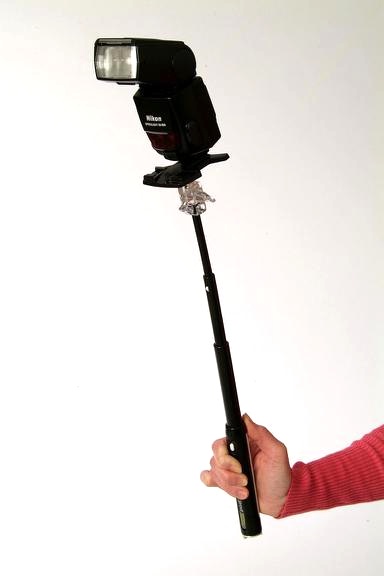
The Quik Pod Pro + package also ships with a mini tripod attachment that can be used alone in table top mode, as shown in this shot, and the one below of it mounted with my Olympus OM-1 35 millimeter SLR.
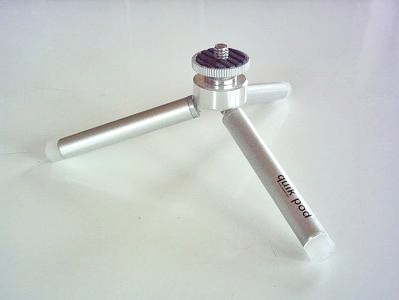
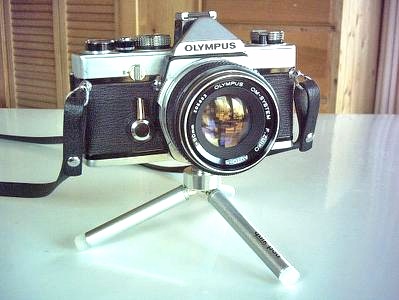
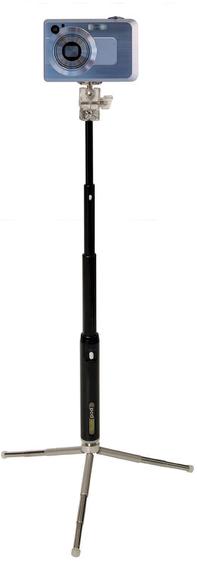 An aside; I bought the OM-1 34 years ago last month, for Can$329.00, which was serious money back in 1974. I’ve put a lot of film through it over the years, even used it has a tool of my livelihood for a time, and it’s still takes superb pictures a third of a century on. It’s been largely sidelined by digital technology these days, but you can safely bet the farm that none of the high-tech digital cameras we’re using today will be of any practical use - if working at all, in 2042. Of course, neither will I in all likelihood. The only trouble I’ve experienced with the OM-1 is that its only electronic component, the light meter, quit working around 1980, and I never bothered getting it repaired, since by preference I use a Gossen hand held light meter anyway.
An aside; I bought the OM-1 34 years ago last month, for Can$329.00, which was serious money back in 1974. I’ve put a lot of film through it over the years, even used it has a tool of my livelihood for a time, and it’s still takes superb pictures a third of a century on. It’s been largely sidelined by digital technology these days, but you can safely bet the farm that none of the high-tech digital cameras we’re using today will be of any practical use - if working at all, in 2042. Of course, neither will I in all likelihood. The only trouble I’ve experienced with the OM-1 is that its only electronic component, the light meter, quit working around 1980, and I never bothered getting it repaired, since by preference I use a Gossen hand held light meter anyway.
It would be cool if Olympus to offer a reasonably priced digital back for the OM-1, so I could get more mileage out of my collection of OM -mount lenses, but I’m daydreaming. Pardon the digression.
The Quik Pod’s mini-tripod module can also attached to the handle end of the Quik Pod, whose handle end cap screws off, thus creating a light-duty elevated tripod. Very slick.
The Quik Pod frees you when traveling from depending on the kindness of strangers for taking photos of you in front of the Eiffel Tower or the Taj Mahal.
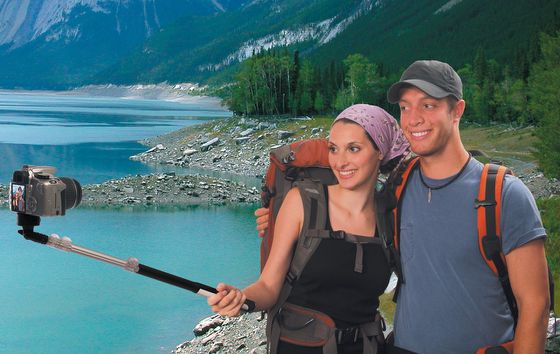
Other potential uses for the Quik Pod include underwater photography (it’s rugged and durable enough to be used even in salt water) if you have a waterproof camera or housing, holding your camera aloft to shoot above crowds at concerts or other events, taking photos in hard-to-reach spots, and around corners - spycam-style, and good for solo video blogging on the move with a digital camcorder.
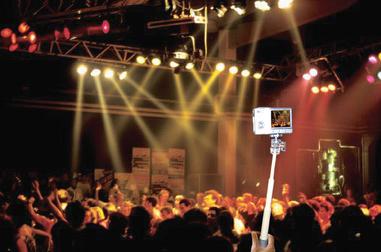
Optional accessories include a Magnet Base for mounting on metallic surfaces like car bodies or refrigerator doors, and a Suction Base to attach your Quik Pod to a variety of smooth surfaces, even a vehicle window or windshield.
In summary, I think the Quik Pod is a grand gadget. It’s relatively cheap, seems reasonably will constructed out of polycarbonate, stainless steel, and aluminum, is a multitasker for a variety of useful things, and best of all - it’s fun. If you like photography, and would enjoy getting in the picture yourself more often, Quik Pod is for you.
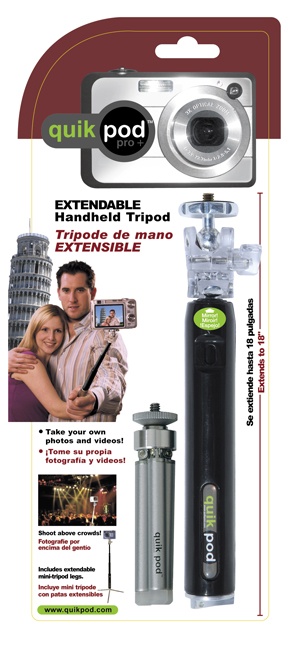
The basic package is priced at US$24.95 complete with Quik Pod, carry bag, hiking clip, pocket clip and wrist strap.
Quik Pod Pro+ Kit (includes carry bag, hiking clip, pocket clip and wrist strap and adapter legs) for $29.95
There is also now a Quik Pod DSLR model with more than four feet of extended camera reach priced at $49.95.
Quik Pod DSLR Specifications:
• High quality polycarbonate and aluminum components for strength, durability and portability
• Works with digital SLR cameras, camcorders and portable lights
• Built-in mirror for overhead shots and self-positioning
• Retracted size - 18 inches (45cm)
• Extended size - 53 inches (135cm)
• Weight - 9oz (250 grams)
• Quick Release Camera Mount
Tripod mount - Universal 1/4-20 screw
• Includes Quik Pod DSLR, machined aluminum end cap, wrist strap, gel pad for body brace comfort, hiking clip, carry bag, hiking clip and rubberized monopod adapter tip.
• Maximum suggested weight of camera/camcorder/lighting is 6 lbs. (3000 grams) when used as a monopod
The Quik Pods can be purchased in the USA at Amazon.com, B&H Photo, Adorama, Ritz, J&R Computer World and in Canada at Blacks Photo, Henrys, Vistek, and The Shopping Channel or ordered online at:
http://www.quikpod.com
Note: Letters to PowerBook Mystique Mailbag may or may not be published at the editor's discretion. Correspondents' email addresses will NOT be published unless the correspondent specifically requests publication. Letters may be edited for length and/or context.
Opinions expressed in postings to PowerBook Mystique MailBag are owned by the respective correspondents and not necessarily shared or endorsed by the Editor and/or PowerBook Central management.
If you would prefer that your message not appear in PowerBook Mystique Mailbag, we would still like to hear from you. Just clearly mark your message "NOT FOR PUBLICATION," and it will not be published.
CM